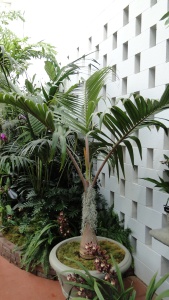Although critically endangered in the wild, these small, slow-growing palms are not uncommon garden trees in tropical regions. Their bottle-shaped trunk looks similar to a caudex but does not hold large quantities of water.
Hyophorbe lagenicaulis (Bottle Plam)
Deciduous: no
Hardiness Zones: 10-11, frost tender
Height: to 6 meters (20 feet) tall
Diameter:to 6 meters (20 feet) in diameter at maturity
Growth Rate: slow
Age: unknown
Root System: fibrous
Family: Palmae
Subspecies: none
Tolerates: very salt tolerant, minimal drought once mature, powerful winds (including hurricanes)
Problems (major): Temperatures below 0 Celsius (32 Fahrenheit) fatal
Problems (minor): slow growth
Poisonous: no
Soil requirements: prefers nutrient-rich, sandy/light, well-drained soils, prefers triannual fertilizers
Air requirements: tolerant of salt spray from oceans
Watering requirement: moderate
Sun requirement: full sun or partial shade (preferred)
Leaves: 4-8 pinnate, feather-like, to 3 meters (10 feet) long, leaflets to 0.6 meters (2 feet) wide
Flowers: small, round, white
Fruits: spherical, initially green, black when mature
Seeds require stratification: no
Trunk: bottle-shaped, swollen, smooth, gray
Form: bottle-shaped with usually 6 leaves at any one time
Monoecious/Dioecious: monoecious
Monocot/Dicot: monocot
Notable characteristics:
These were nearly driven to extinction from their native range (Round Island) in the Indian Ocean.
Uses:
These are usually grown as ornamental garden plants.
Sources used:
- http://www.floridata.com/ref/H/hyop_lag.cfm
- http://www.arkive.org/bottle-palm/hyophorbe-lagenicaulis/
- http://www.iucnredlist.org/details/38580/0
- http://edis.ifas.ufl.edu/pdffiles/FR/FR30700.pdf
- http://bottle-palms.com/
- http://www.llifle.com/Encyclopedia/PALMS_AND_CYCADS/Family/Arecaceae/24506/Hyophorbe_lagenicaulis
- http://www.palmtreepassion.com/bottle-palm-tree-care.html#.VQGXzNLF9sQ
http://www.botany.hawaii.edu/faculty/daehler/wra/full/Hyophorbe%20lagenicaulis%20SA.xls

Foliage with prominent midrib/mid-vein

Form when young (at Missouri Botanical Garden orchid show)
All of the images provided were taken by me. They may be used for educational/informational purposes only, provided that this article/online journal is appropriately cited first.
